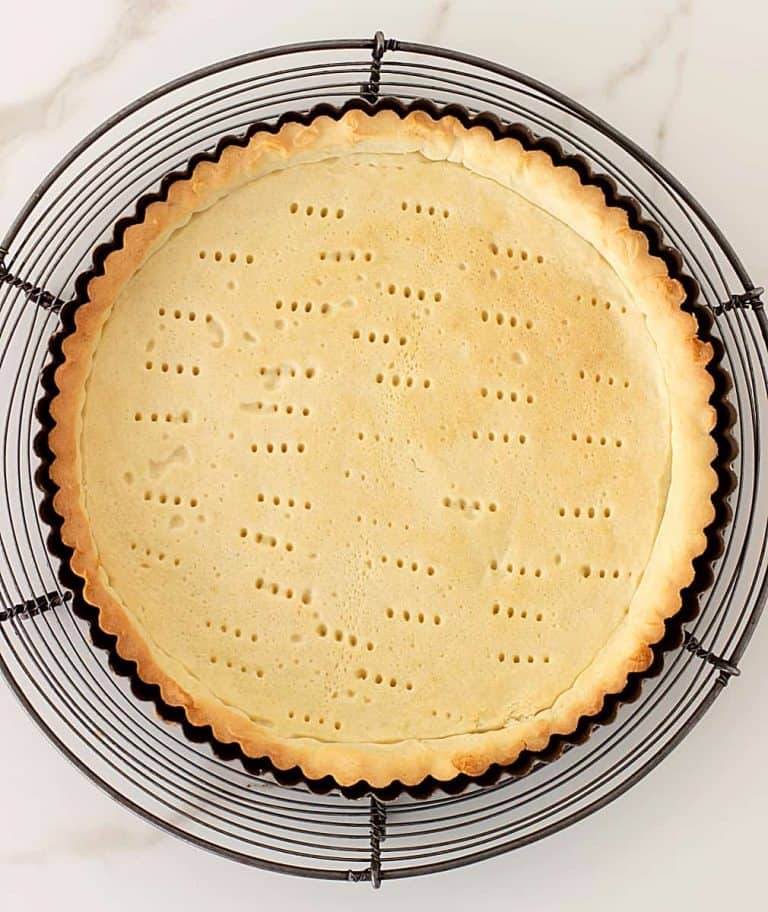Ingredients
- 3/4 cup (120g) powdered sugar
- Pinch of salt
- 1 3/4 cups (250g) all-purpose or cake flour
- 1/2 cup + 1 tablespoon (125g) unsalted butter, at room temperature
- 1 egg, at room temperature
Instructions
- In a large bowl cream butter with a spatula or wooden spoon until it is smooth.
- Add powdered sugar and mix until all is incorporated.
- Add egg and mix with a fork. It will not be smooth or completely incorporated. That is fine.
- Add half of the flour and the salt.
- Mix it but don’t wait until the flour is completely incorporated before adding the second half.
- Now, mix it until lumpy and few dry spots remain.
- Turn it out onto a clean surface or counter and mix with your hands, trying to make it come together but touching it as little as possible.
- When you have a smooth dough ball, wrap it in plastic and refrigerate for at least 1 hour and up to 2 days.
- When ready to roll, take the dough from the fridge and let barely soften at room temperature. The dough must still be cold. Simply wait until you can start to roll it, but not until it is very soft. This is important to ensure a tender dough.
- On a lightly floured counter, start rolling the dough disc, making sure you do quarter turns (I do them to the left) often to ensure the dough is not sticking and adding more flour to the counter if it is sticking.
- Once you have the dough rolled a few inches larger than the pan, fold it in half and place the fold in the middle of the pan.
- Open the dough and line the pan, being careful not to stretch the dough. Use your hands to lower the dough and reach the union between the bottom and sides of the pie pan.
- Go over the rim of the pan with the rolling pin to remove excess dough.
- Prick the bottom with a fork, freeze for 20 minutes, or put it in the refrigerator for 1 hour. At this point, you can leave the dough frozen in the pan for up to a month, wrapped in plastic.
- Or you can blind-bake it or bake it completely, depending on what you’re making. (Every pie or tart recipe in this blog has the steps to bake the pie crust. This post is about how to make and store the pastry).
- Preheat the oven at 350°F /180°C.
- How to prepare a pie crust for blind baking: take out the cold lined pie pan from the fridge or freezer.
- Cut a piece of aluminum paper that is larger than the tart pan. Line the inside of the pan by covering the cold dough with it and adjusting it so that it takes the shape of the dough. You can also use parchment paper, but it's usually coarser and more difficult to make it take the shape of the pan and cover the dough well.
- Add weight. I use round ceramic weights that you can buy online, but you can add any raw grains and legumes such as beans, lentils, rice or even flour (simply fill the aluminum paper with flour or rice or whatever you're using until you have added a layer of weight that will be enough to keep the paper down during baking.
- Bake for 15 minutes. It might be a few minutes more or less depending on the type of pie crust, but the idea is to let the dough bake and dry out enough so that we can lift the aluminum paper without it attaching to the raw dough. The paper should lift easily and the dough below will be half baked, very lightly golden. Fill and bake further following instructions in the recipe for the tart or pie you're making.
- To completely bake the shortcrust pastry: first, follow the steps to blind bake it, above.
- After removing the paper and weight, return the pan to the oven and bake for another 10-15 minutes, depending on how golden you want it. The crust should be dry. Let cool on a wire rack.
- If fully baked it will keep for a few days in a metal tin or at room temperature if the place is dry and cool. But I suggest you bake it the day you’re filling it.
Notes
Organization: read the recipe first and make sure you have ingredients at the right temperatures, equipment needed, and enough workspace. This will make the process so much easier!
Baking time: all ovens and pans are different, even if they look the same or very similar. The baking time in my recipes is as accurate as it can be, but it might take you more or less time. Use a thermometer inside the oven (like the OXO oven thermometer) to check that the temperature is right. I recommend you keep track of how your oven works and what tiny details you might need to adjust.
Food processor: you can use this small appliance. It's important not to overprocess it once the flour is added or gluten will start to develop. We don't want that as it
Video recipe: watch videos for Making the sweet pie dough and Rolling and lining pie dough.
- Prep Time: 20 minutes
- Resting time: 60 minutes
- Cook Time: 20 minutes
- Category: Pies & Tarts
- Method: Mixing
- Cuisine: International
Nutrition
- Serving Size: 1/8
- Calories: 234
- Sugar: 9.3 g
- Sodium: 301.7 mg
- Fat: 10.9 g
- Carbohydrates: 30.3 g
- Fiber: 0.7 g
- Protein: 3.7 g
- Cholesterol: 50 mg
